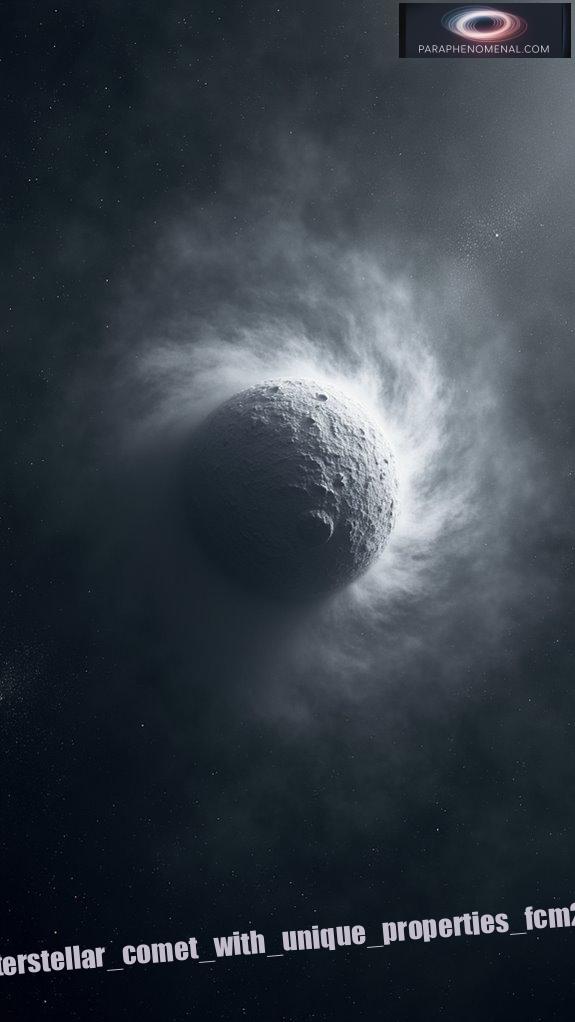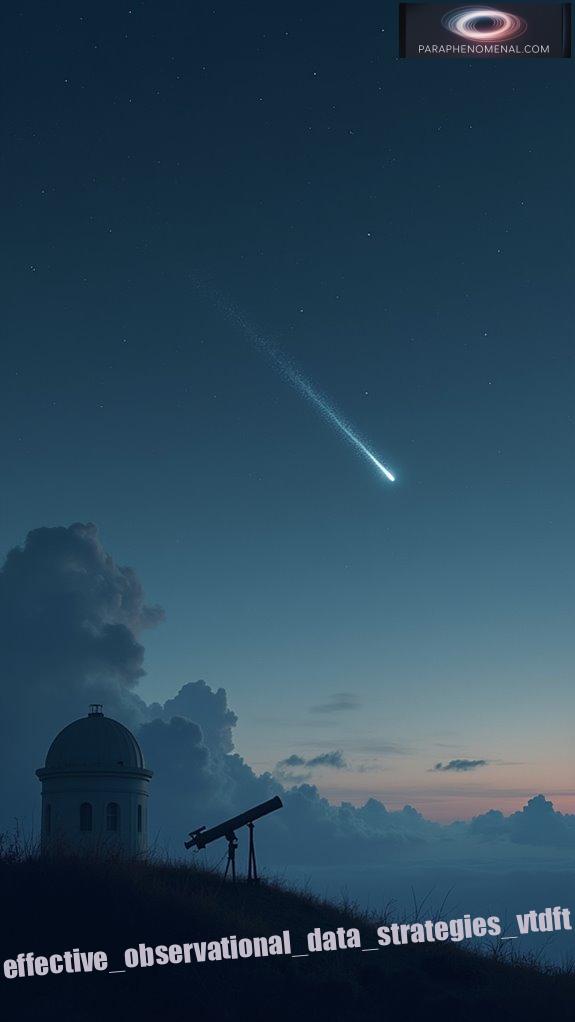Have you ever wondered what secrets lie within the icy depths of a comet?
Comet 3I/ATLAS is a celestial treasure trove, with a nucleus ranging from 1,000 feet to 3.5 miles.
Its surrounding coma, filled with volatile ices, could reveal insights into our universe’s origins.
Imagine embarking on a mission to scoop up this cosmic dust and gas!
With launch windows opening between July and September 2025, these flythrough missions may transform our understanding of interstellar comets and their mysterious role in cosmic phenomena.
Don’t you want to know what we’ll find?
H2: My Close Encounter with the Unknown
As a curious explorer, I’ve always been captivated by both comets and UFO phenomena. One night while stargazing, I witnessed a series of strange lights dancing in the skies. They flickered, shifted, and coalesced before disappearing into the vastness of space.
Was it a secret spacecraft, an alien encounter, or simply a natural phenomenon? That moment reignited my passion for understanding the universe—both in terms of its physical wonders, like comets, and the enigma of extraterrestrial life. Moments like these compel us to inquire: What else is hidden among the stars?
Quick Takeaways
- Launch windows for missions to Comet 3I/ATLAS are best between July and September 2025.
- Mars-based launches require less velocity change (5 km/s) compared to Earth-based launches (24 km/s).
- Flythrough missions enable direct sampling and in situ analysis of volatile compounds in the comet’s coma.
- Observational data collection strategies include international monitoring and citizen science for continuous tracking of the comet.
- Potential discoveries from the mission include unique molecular complexes and insights into interstellar chemistry and cometary evolution.
Characteristics of Comet 3I/ATLAS

Comet 3I/ATLAS has intrigued astronomers since its discovery due to its unique characteristics and interstellar origin.
The nucleus of this comet is estimated to be between 1,000 feet and 3.5 miles in diameter, but its exact size remains elusive, hidden within a veil of dust. This icy, solid core is surrounded by a diffuse coma, formed from sublimated volatile ices, generating significant cometary activity. Recent photometry has revealed that the comet has a color indices measured as g-r = 0.43±0.02 mag, r-i = 0.16±0.02 mag, and g-i = 0.59±0.03 mag. The composition of the nucleus may include a mix of volatile ices, which are critical in understanding its physical properties.
The dust properties are equally fascinating; it ejects particles at a speed of about 0.01 to 1 m/s. The comet also sheds dust at a rate of 0.1 to 1.0 kg/s, revealing a dynamic environment.
Understanding these nucleus characteristics and dust properties enhances our knowledge of interstellar bodies and fuels our intrigue, which is why we created this website, ParaPhenomenal.
Scientific Importance of Flythrough Missions
Exploring the scientific importance of flythrough missions reveals how they directly enhance our understanding of comets like 3I/ATLAS.
With flythrough technology, you get direct sampling of the cometary coma, allowing for real-time in situ analysis of volatile compounds like water and organic materials. This access bypasses the limitations of remote observations, enabling precise data collection that can validate existing cometary models. Additionally, the orbit determination process for these missions ensures accurate tracking of the spacecraft’s position, crucial for effective flythrough operations. Recent data from NASA missions have illustrated how such interactions can impact our understanding of cometary behavior.
Flythrough technology enables real-time sampling of cometary comas, revolutionizing our understanding of volatile compounds and validating cometary models.
By documenting gas and dust activities as the comet approaches the Sun, these missions better reveal solar interactions and ejection mechanisms.
Understanding complex organic molecules can also shed light on life’s origins, hinting at how comets might’ve contributed to Earth.
At ParaPhenomenal, we aim to deepen this knowledge through such innovative exploration.
Mission Design and Feasibility
Designing a mission to intercept 3I/ATLAS involves a careful assessment of technical requirements, timelines, and launch strategies. You’ll find launch windows between January 2025 and March 2026, with the best opportunities from July to September 2025, especially for Mars-based launches. The comet’s unique orbital eccentricity plays a critical role in determining its trajectory and accessibility for mission planning.
Trajectory optimization is vital, as existing software can calculate low-energy paths to reach the comet. With Earth-based launches needing a velocity change of at least 24 km/s, Mars-based options offer a more feasible 5 km/s. Additionally, the discovery of 3I/ATLAS reinforces the mission concept for comet interception, highlighting the importance of timely planning.
Efficient propulsion planning is essential, so ensuring spacecraft, like Janus, is equipped with suitable instruments will maximize data collection. Planning must occur quickly to catch 3I/ATLAS, reinforcing our commitment at ParaPhenomenal to explore the mysteries of the cosmos.
Observational Data Collection Strategies

As scientists aim to reveal the secrets of 3I/ATLAS, effective observational data collection strategies play an essential part in piecing together its origins and behavior.
Utilizing pre-discovery data recovery, researchers comb through archival images to extend the timeline of 3I/ATLAS, capturing faint signals through image stacking techniques.
Multi-wavelength optical monitoring brings international observatories together, while citizen science networks enhance data integration and continuous tracking through small telescopes.
Radio and submillimeter surveillance, managed by the SETI Institute, accumulates valuable spectral data, searching for both cometary molecules and technosignatures.
High-resolution spectroscopy will soon provide understanding into the comet’s unique volatile inventory, revealing more about its composition. Additionally, NASA missions are crucial in facilitating detailed investigations of cometary phenomena and gathering critical insights.
ParaPhenomenal seeks to present these findings, fostering a deeper understanding of our cosmic neighborhood.
Potential Scientific Discoveries
What secrets could Comet 3I/ATLAS reveal about the universe?
This comet offers a unique chance to explore interstellar chemistry and understanding into cometary evolution.
You could uncover:
- Unusual molecular complexes, like nickel attached to PAHs, potentially unique to interstellar comets.
- Distinctive chemical signatures that highlight differences compared to solar system comets, offering clues about their formation in different environments.
- Revelations into dark, icy mixtures present in the comet’s coma—shedding light on the building blocks of other star systems.
Future Exploration Opportunities
How can we best take advantage of the upcoming opportunities to explore Comet 3I/ATLAS?
As the comet approaches perihelion, you’ll want to reflect on how its trajectory influences your mission planning. The flythrough allows for unique studies of its coma and nucleus, revealing revelations into its cometary origin and potential interstellar implications.
By using existing technology and mission profiles, you can implement low-energy trajectories for your spacecraft, reducing costs and maximizing scientific returns.
The collaboration with ESA’s JUICE spacecraft will also enhance observations post-perihelion. Additionally, understanding the concept of hyperbolic trajectory will be crucial in precise mission design as the comet travels through our solar system.
This is an exciting chance to engage with unexpected discoveries, and by being responsive to the comet’s changes, you can contribute to our understanding of celestial phenomena, shaping future missions and expanding our cosmic outlook.
FAQ
What Is the Origin of Comet 3i/Atlas?
You’re looking at a true cosmic wanderer, 3I/ATLAS, born far outside our Solar System.
Its cometary formation dates back about 7.5 billion years, making it a remarkable time capsule. This ancient relic offers a unique glimpse into the universe’s early stages.
Though it came from another star system, it slipped into our cosmic neighborhood, showing us that history floats through the stars, just waiting to be recognized.
How Does Its Composition Compare to Other Comets?
The composition of comet 3I/ATLAS stands out from other comets due to its unique volatile compounds.
Spectral analysis reveals a gas plume rich in nickel, unlike any known comet. While many comets release significant amounts of water ice, 3I/ATLAS lacks strong sublimation features.
These differences challenge existing knowledge about comet chemistry. Investigating such distinctive features enriches our understanding of interstellar objects, which is why we created ParaPhenomenal—to explore the unknown.
Will 3i/Atlas Be Visible to the Naked Eye?
No, 3I/ATLAS won’t be visible to the naked eye under current visibility conditions.
Most interstellar comets, like 3I/ATLAS, remain faint due to their distance and small size.
While it’s intriguing to think about spotting this cosmic traveler, you should expect it to stay dim, similar to its predecessors.
Explore with us at ParaPhenomenal, where we investigate such mysteries, but for now, don’t count on seeing this comet in the night sky.
What Technologies Will Be Used in the Flythrough Mission?
The flythrough mission will use advanced imaging technology and trajectory planning to study comet 3I/ATLAS.
A spacecraft will employ a low-energy flythrough trajectory, optimizing launch windows while minimizing propulsion needs.
Onboard instruments, like mass spectrometers and dust analyzers, will analyze the comet’s composition and plasma environment.
This meticulous approach aims to capture detailed data that deepens our understanding of comets, showcasing the innovative technologies we explore on this website, ParaPhenomenal.
How Can Amateurs Get Involved in Observing 3i/Atlas?
To get involved in observing Comet 3I/ATLAS, immerse yourself in amateur astronomy with the right observation techniques.
Equip yourself with a telescope or binoculars for better visibility as it brightens in early November. Use planetarium software to pinpoint its location in the sky.
Long-exposure photography can capture its elusive beauty, while joining online forums offers a chance to share discoveries and learn from fellow enthusiasts.
Get ready for a cosmic adventure!
References
- https://science.nasa.gov/solar-system/comets/3i-atlas/
- https://www.youtube.com/shorts/YaeuELVRTgw
- https://www.swri.org/newsroom/press-releases/swri-proposed-mission-could-encounter-explore-future-interstellar-comet-3i-atlas-close
- https://science.nasa.gov/blogs/planetary-defense/2025/07/02/nasa-discovers-interstellar-comet-moving-through-solar-system/
- https://ffesp.org/nasa-confirms-3i-atlas-mysterious-interstellar-visitor-enters-solar-system/
- https://astrobiology.com/2025/07/interstellar-comet-3i-atlas-discovery-and-physical-description.html
- https://arxiv.org/abs/2507.05252
- https://ui.adsabs.harvard.edu/abs/2025MNRAS.542L.139B/abstract
- https://www.seti.org/news/comet-3iatlas-a-visitor-from-beyond-the-solar-system/
- https://science.nasa.gov/missions/hubble/as-nasa-missions-study-interstellar-comet-hubble-makes-size-estimate/
- https://science.nasa.gov/learn/basics-of-space-flight/chapter13-1/
- https://exploredeepspace.com/scientific-exploration/
- https://www.lockheedmartin.com/en-us/capabilities/space/deep-space-exploration.html
- https://spaceinsider.tech/2024/03/14/the-benefits-of-space-exploration-and-its-importance/
- https://www.apu.apus.edu/area-of-study/math-and-science/resources/why-should-we-explore-space/
- https://agupubs.onlinelibrary.wiley.com/doi/full/10.1029/2021SW003031
- https://science.nasa.gov/science-missions/
- https://www.nasa.gov/humans-in-space/why-go-to-space/
- https://www.ncbi.nlm.nih.gov/books/n/nap26750/sec_ch4/
- https://www.iflscience.com/two-spacecraft-to-fly-through-comet-3iatlass-ion-tail-will-they-be-able-to-catch-something-81195
- https://www.youtube.com/watch?v=bwJgcflf0lM
- https://arxiv.org/html/2507.15755v2
- https://www.planetary.org/articles/where-do-3i-atlas-and-other-interstellar-visitors-come-from
- https://thedebrief.org/3i-atlas-update-what-new-data-reveals-about-the-most-puzzling-interstellar-object-ever-found/
- https://arxiv.org/abs/2507.12922
- https://www.spectroscopyonline.com/view/interstellar-comet-3i-atlas-shows-mysterious-spectroscopic-activity
- https://astrobiology.com/2025/07/assessing-interstellar-comet-3i-atlas-with-the-10-4-m-gran-telescopio-canarias-and-the-two-meter-twin-telescope.html
- https://en.wikipedia.org/wiki/3I/ATLAS
- https://www.iflscience.com/anti-tail-and-odd-594-kilometer-feature-found-on-interstellar-object-3iatlas-by-keck-observatory-81188
- https://www.iflscience.com/prof-brian-cox-explains-what-he-finds-remarkable-about-interstellar-object-3iatlas-story-81168
